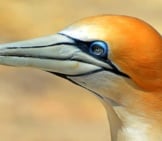Gannets are a group of seabirds in the taxonomic genus Morus. Within the genus, there are just three species, each of which lives in a completely different region. The three species of gannets are the northern gannet, the Cape gannet, and the Australasian gannet. All three species are light colored, with thick, pointed bills. Read on to learn about the gannet.
Description of the Gannet
All species of gannets are relatively large birds, weighing in at around five pounds or so. Their wingspan sometimes reaches nearly seven feet across, and their bodies are up to three feet long. Though they are separate species, all three types of gannet are similar in appearance.
Their plumage, or feathers, is primarily white, while the feathers on their wings and tail are black. Their heads also have a yellowish hue over the feathers.
Interesting Facts About the Gannet
Though they look similar, each species of gannet is unique. Learn more about the individual gannet species below.
- Northern Gannet – Of all the seabird species in the North Atlantic Ocean, the northern gannet is the largest. Their wingspan is expansive, and often surpasses 6 ft. across. They are also incredibly fast, and can fly over 35 miles per hour!
- Cape Gannet – You can distinguish this species of gannet from its relatives by looking at the markings on its throat. The cape gannet has a long dark strip down its throat, which is more prominent than its other relatives.
- Australasian Gannet – While cape gannets feed in small groups even while they are outside of their breeding colonies, Australasian gannets are a little more unwilling to share. Unfortunately for them, they often become unwilling members of feeding flocks. When one gannet spots food, it would prefer not to share that food with others, but its sharp-sighted neighbors often join in.
Habitat of the Gannet
Because they are seabirds, you might guess that gannets live in the ocean. However, unlike some seabirds, gannets usually live near coasts and islands rather than the open ocean. In fact, it is rare for these birds to stray much farther than 100 miles from shore. During the breeding season they seek isolated islands to nest on.
Distribution of the Gannet
Each species of gannet lives in a different region. The northern gannet ranges from the eastern coast of Canada down into the Gulf of Mexico. They also range throughout the coasts of Europe and northern Africa.
The Cape gannet lives along the coast of western and southern Africa. Finally, the Australasian gannet lives along the coasts of Africa, New Zealand, and other surrounding islands.
Diet of the Gannet
Each species of gannet has a different diet, and even within a species birds in different regions eat different prey. They primarily prey on fish and squid. Marine predators, like dolphins and sharks, frequently seek schools of fish to hunt.
Gannets find these feeding frenzies and join in the fray. Some of the various species that they eat include capelin, cod, garfish, coalfish, whiting, pilchard, and haddock.
Gannet and Human Interaction
Fishermen do not like gannets, particularly if they fish near a nesting colony. Nesting birds eat lots of fish, and this does lead to conflict between the fishermen and the birds. Sadly, conflict with humans nearly always leads to trouble. Though these threats do not impact some species of gannets as heavily, others suffer. The IUCN lists northern gannets as Least Concern, Australasian gannets as Least Concern, and Cape gannets as Endangered.
Domestication
Humans have not domesticated any species of gannet in any way.
Does the Gannet Make a Good Pet
Not only are gannets quite large, but they also have huge appetites. These birds eat a lot of fish and squid, and what comes in must come out. Their poop is incredibly smelly and messy, and this alone makes them poor pets. In many places, it is also illegal to own a gannet as a pet.
Gannet Care
In zoos, these large birds need lots of space to spread their wings. Their enclosures are large, and must feature some type of large water source for swimming and bathing. Gannets in zoos help teach visitors about the various dangers facing seabirds today, including pollution, over-fishing, and more. Zookeepers feed gannets a diet of fish and squid.
Behavior of the Gannet
Each species of gannet has slightly different behavior. Some species are solitary while they are feeding or anytime they are not breeding; others live in small flocks and feed together. Most species congregate around a plentiful food source, albeit some do so involuntarily. During the breeding season, flocks of gannets come together to form colonies on breeding islands.
Reproduction of the Gannet
Most gannets are monogamous, and breed with the same partner year after year. They perform mating rituals and courtship dances, both to form bonds and rebuild them when they reach the breeding colonies.
Females lay one or two eggs, and incubate them for about a month and a half before they hatch. Once the chicks hatch they are entirely dependent on their parents for food and protection. At about three months old they begin to fly, and after a week or so they are independent.













![Red Angus Closeup of a beautiful Red Angus cowPhoto by: U.S. Department of Agriculture [pubic domain]https://creativecommons.org/licenses/by/2.0/](https://animals.net/wp-content/uploads/2020/03/Red-Angus-4-238x178.jpg)












![Red Angus Closeup of a beautiful Red Angus cowPhoto by: U.S. Department of Agriculture [pubic domain]https://creativecommons.org/licenses/by/2.0/](https://animals.net/wp-content/uploads/2020/03/Red-Angus-4-100x75.jpg)

